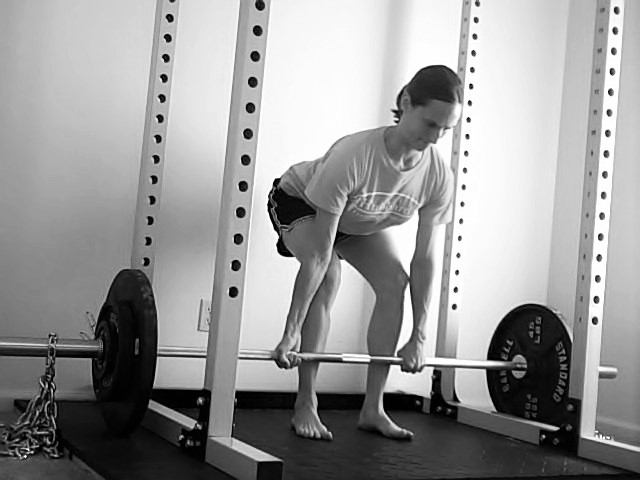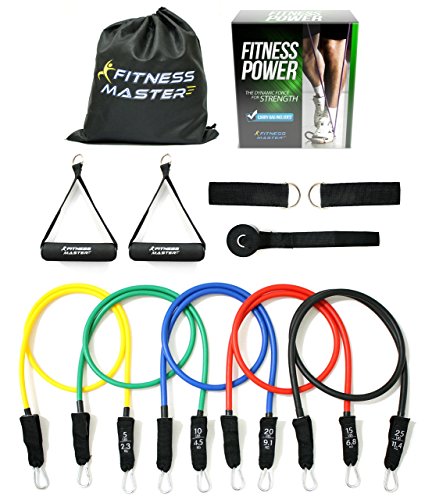Performance improvement is a mandatory element of a proper strength training program.
There are many ways to fulfill this requirement (e.g., increase the volume by performing more sets, decrease the rest periods between sets/exercises thereby increasing the density of the workout, etc.) but the two most common ways to improve performance: perform more reps with the same weight, and increase the weight used.
When you combine the latter two ways into a single method to improve performance, you get what’s known as double progression. Gradually perform more reps with the same weight, and then increase the weight used and start the process over.
The double progression strength training method is one of my favorites. It’s simple, and effective as hell for getting stronger and improving your performance. From beginners to advanced trainees, for building maximum strength to building muscle or just performing a well-rounded strength training program — it just works. From barbells, dumbbells, kettlebells, and even cable machines and other equipment, the double progression method is an effective training method.
To bring this to life, let’s use an example of a total body strength training workout that revolves around a few big, basic exercises:
- Squat — 4 x 8-10
- Dumbbell bench press — 4 x 8-10
- One arm dumbbell row — 4 x 8-10
In this workout example, each exercise is performed for four sets, 8-10 reps per set, utilizing the double progression strength training method.
Important Notes for Double Progression
- Start at the low end of the provided rep range
- Use the same weight for all sets
- Each time you repeat the workout, perform an extra rep (either one rep at a time, or adding one additional rep to every set — more on this later)
- Once you perform all sets, with the same weight, at the high end of the provided rep range, increase the weight by a few pounds and start back at the low end of the rep range
- One more important note that requires elaboration …
Start out easy. Heeding this suggestion can make all the difference. Sticking with the sample workout above, begin with a weight you know you could perform for 10, or even 12, perfect reps. But start out performing eight reps. By intentionally starting out a bit easy and gradually increasing your performance each time you repeat the workout, you’re providing “growing room” from the beginning and ensuring you can improve your performance, gradually and steadily, for many weeks (or even months).
You’ll also build confidence because you’ll dominate every single rep of every set you perform, you’ll be able to milk out strength gains for a longer period of time, and you’ll likely stay healthy from not pushing too hard too quickly.
There are different suggestions for beginners and advanced lifters on how to best use the double progression strength training method.
Beginners can perform an extra rep for each set every time they repeat the workout until they reach the high end of the provided rep range. Here’s how a hypothetical beginner-trainee would use the double progression method with the above workout over the course of 10 weeks.
Remember, the same weight should be used for all work sets, and start out too easy — a good estimate would be a weight the trainee knows she can dominate for 10-12 reps. (Note: total reps performed are shown in parentheses; this will be used in a following explanation.)
NOTE: 4 x 8 x 95 means 4 work sets, 8 reps performed per set, and 95 is the weight used for each set, for sake of the example.
- Week 1 — 4 x 8 x 95 (32 totals reps)
- Week 2 — 4 x 9 x 95 (36 total reps)
- Week 3 — 4 x 10 x 95 (40 total reps)
- Week 4 — 4 x 8 x 100* (32 total reps)
- Week 5 — 4 x 9 x 100 (36 total reps)
- Week 6 — 4 x 10 x 100(40 total reps)
- Week 7 — 4 x 8 x 105* (32 total reps)
- Week 8 — 4 x 9 x 105 (36 total reps)
- Week 9 — 4 x 10 x 105 (40 total reps)
- Week 10 — 4 x 8 x 110* (32 total reps)
*The weight increased five pounds these weeks and the cycle started over: return to the low end of the rep range with the new, slightly heavier weight and start the process over.
That method of double progression works beautifully for beginners, and even intermediates. For advanced trainees, an even slower improvement in performance is recommended. Why? Because an advanced trainee is significantly stronger, so improvements in performance come slower, and in much smaller increments.
For an advanced trainee using the double progression method, each time the workout is repeated, perform just one total extra rep. Not one extra rep per set as with the beginner example above; just one additional rep, beginning with the first set and adding one to each subsequent set when you repeat the workout.
Continuing with the example workout above (4 x 8-10 per exercise) here’s how the progression would look each time the advanced-trainee repeated the workout, assuming this workout was performed once per week.
- Week 1 — 4 x 8 (32 totals reps)
- Week 2 — 1 x 9, 3 x 8 (33 total reps)
- Week 3 — 2 x 9, 2 x 8 (34 total reps)
- Week 4 — 3 x 9, 1 x 8 (35 total reps)
- Week 5 — 4 x 9 (36 totals reps)
- Week 6 — 1 x 10, 3 x 9 (37 total reps)
- … and so on until you reach 4 x 10. Then increase the weight five pounds and repeat.
See the difference? Whereas the beginner method of double progression improved performance for all sets each time the workout is repeated (thereby, in this example, performing four more reps per workout), the advanced method improves performance by a single rep each time a workout is repeated.
Slow improvements, but you’ll be able to sustain them for several weeks, even months. This more gradual method is also great for older trainees, or those who prefer or need slower improvements so they feel great and don’t get beat up from training.
Different Rep Ranges
The double progression method is versatile; it works for any rep range. Want to build maximum strength? Use a 3-5 rep range. Want to improve muscular endurance? Use a 15-20 rep range. Whatever goal you have (or simply to provide variety), the double-progression method can be used successfully. I recommend a two-rep buffer at the minimum (e.g., 3-5 or 8-10), but you can use a five-rep buffer successfully too (e.g., 15-20).
And, of course, you can use different rep ranges for different exercises, or even across different workouts. (Example below under Putting It All Together.)
When using dumbbells or kettlebells, I prefer a minimum of a three-rep buffer, and five being even better. The reason is simple: a five pound increase is a big jump compared to a five pound increase with a barbell exercise. For example, going from a 30 pound dumbbell press to a 35 pound dumbbell press is almost a 20% increase in weight, even though it’s “only” a five pound jump. This can be a tremendous amount for something like an overhead press that naturally can’t handle as much weight compared to a squat, or even a dumbbell row.
For dumbbells and kettlebells, stick with the same weight until you can complete at least 3-5 more reps with the same weight before increasing it. (Note: this is why I love adjustable dumbbells. The set I have in my home gym allows me to increase the weight by 2.5 pounds, which is a more manageable load.)
Double Progression and Bodyweight Exercises
Double progression works tremendously well with bodyweight exercises too.
Using the traditional 8-12 rep range, use a variation of a bodyweight exercise that you could perform for 12 perfect, solid reps; but only perform sets of eight reps at first, and gradually work your way up to 12 reps with the same variation. Then, once you perform 12 reps for all sets with the same variation, make the variation a bit more challenging, and repeat the process over. (For a video demonstration of how to make push-ups easier and more challenging, check out this beginner strength training guide.)
How would this look? Take push-ups, for example. You can perform them on an elevated surface (remember, with this example, have the surface high enough so you could perform 12 perfect reps, but only perform eight). Then, once you reach 12 reps, you would use a slightly lower surface (two inches or so should work well) to make the exercise a bit more difficult.
If your goal is building maximum strength, you can use the 3-6 rep range. The double progression method is a terrific way to get stronger with bodyweight exercises and gradually progress to more challenging variations; it’s one of my favorite methods for progressing trainees to their first bodyweight pull-up. Check out this article on how to properly perform band assisted pull-ups; apply the double progression method to those band assisted variations and you’ll be on your way to dominating bodyweight pull-ups and parallel bar dips.
Putting It All Together: A Double Progression Program
Here’s a sample double progression program; perform each workout once per week on nonconsecutive days. For maximum variety and to reap the benefits multiple rep ranges offer, this sample program uses low reps (Workout 1), moderate reps (Workout 2), and high reps (Workout 3).
Workout 1
- 1) Front squat — 4 x 6-8
- 2a) Pull-up (or band assisted pull-up) — 4 x 6-8
- 2b) One arm dumbbell push press — 4 x 6-8
Conclude with 10-20 minutes of optional work.
Workout 2
- 1a) Dumbbell bench press — 3 x 10-12
- 1b) One arm dumbbell row — 3 x 10-12
- 2) Barbell Romanian deadlift — 3 x 10-12
Conclude with 10-20 minutes of optional work.
Workout 3
- 1a) Reverse lunge — 3 x 15-20
- 1b) Push-up — 3 x 15-20
- 1c) Inverted row (palms-down grip) — 3 x 15-20
Conclude with 10-20 minutes of optional work.
You’ll notice each workout is comprised of three big exercises. Once you complete each workout you can perform 10-20 minutes of extra, optional, work. This varies depending on your goals but this is where you fit in extra glute work, isolation exercises (e.g., lateral raises, biceps curls, triceps extensions, direct ab work, etc.; yes, the double-progression method works beautifully with isolation exercises too), or interval training to improve conditioning or boost fat loss.
Note: Exercises labeled with just a number (e.g., 1 or 2) are to be performed on their own. Exercises labeled with a number plus letter (e.g., 1a, 1b, and 1c; 2a and 2b) are to be performed in alternating fashion.
What to do When Progress Stalls
Nothing works forever, and double progression is no exception.
Once you struggle to add weight or reps, it’s time to changes things up. The simplest way is to use different exercise variations and start over using the double progression method with the new exercises.
Sticking with the sample workout program above, swap out those exercises for a similar variation. The first exercise shown is the one used in the above program; the second exercise listed is a similar, but different, variation.
Workout 1
- Front squat — back squat
- Pull-up — chin-up
- One arm dumbbell push press — standing barbell press
Workout 2
- Dumbbell bench press — low incline dumbbell bench press
- One arm dumbbell row — chest supported row
- Romanian deadlift — sumo deadlift
Workout 3
- Reverse lunge — rear foot elevated split squat
- Push-up — close grip push-up
- Inverted row — suspension trainer inverted row
Simply plug those new exercises into the sample program above and you’ve got a new workout phase.
Improving your performance is mandatory if you want to improve your strength and fitness, and the double progression method is effective, simply, and methodical in application.
Like what you read? Never miss a thing. Sign up below to join the free newsletter.
The post The Double Progression Method: Elevate Your Strength Training Workout appeared first on Nia Shanks.






